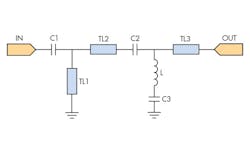MMIC Quadruples Frequencies into Millimeter-Wave Bands
The design and fabrication of technology for natively generating and modulating millimeter-wave signals is expensive and complex. Thus, researchers need techniques and typologies to upconvert or multiply lower-frequency signals. On that front, Catherine Algani of the ESYCOM Laboratory-CNAM, France, together with Wafae El Hamdani, Said Mazer, Moulhime El Bekkali, and Maryam Abata of the Laboratory of Information Processing and Transmission of Sidi Mohamed Ben Abdellah University, Morocco, used the UMS foundry’s PH15 to design a frequency quadrupler that operates at millimeter-wave frequencies.
The research team worked with the UMS foundry to combine monolithic-microwave-integrated-circuit (MMIC) technology with the PH15 process. As a result, the researchers were able to develop a single-stage quadrupler operating with a 14- to 16-GHz local oscillator. The UMS foundry process is based on pseudomorphic-high-electron-mobility (PHEMT) field-effect transistors (FETs). Gate widths of 70.00 and 0.15 μm were used to develop the mutliplier’s circuit components, a quadrupler, a high-pass filter, and a buffer amplifier.
The conclusive design stemming from the research was a quadrupler that reached 60 GHz with a conversion gain of –4.2 dB. The quadrupler demonstrated high harmonic rejection of the second, third, and fourth harmonics to 18.8 dB of the third harmonic. See “Design of a MMIC Frequency Quadrupler In Millimeter-Wave Band,” 2014 International Conference on Multimedia Computing and Systems (ICMCS), Apr. 2014, pg. 1506.
About the Author
Jean-Jacques DeLisle
Jean-Jacques graduated from the Rochester Institute of Technology, where he completed his Master of Science in Electrical Engineering. In his studies, Jean-Jacques focused on Control Systems Design, Mixed-Signal IC Design, and RF Design. His research focus was in smart-sensor platform design for RF connector applications for the telecommunications industry. During his research, Jean-Jacques developed a passion for the field of RF/microwaves and expanded his knowledge by doing R&D for the telecommunications industry.


